Difference between Powerbook and Powerbase
In addition to the complete Fritz Powerbook, ChessBase offers Powerbooks and Powerbases for many special openings. Although they sound similar, they are very different and, at only €9.90 each, are a real bargain:
- A Powerbook is an extensive collection of opening moves. It contains the opening phases of a huge number of games, which can be accessed in a systematic manner. It provides the number of times a move has been played in a position, the probability of winning or drawing, as well as the average Elo rating and performance with the respective move. The Powerbook also contains a very large number of computer games, which explains the sometimes very high Elo ratings and performance values.
- Each Powerbase contains around 10,000 games on a specific topic. The games are included in full and some are annotated. They represent a selection of the best historical and current players from the Mega and correspondence chess databases.
This demonstrates the fundamental difference between the two products. Powerbooks can be used to systematically analyse openings or, as we will show later in this tutorial, to train with Fritz. Powerbases are ideal for understanding opening ideas and the typical positions that arise from them, using annotated top-level games.
Opening Powerbook and Powerbase
After installation, you can access Powerbook and Powerbase in ChessBase and Fritz as a "book" – one of the tabs in the notation window. Here is an example from the Fritz mask, which looks identical in ChessBase:
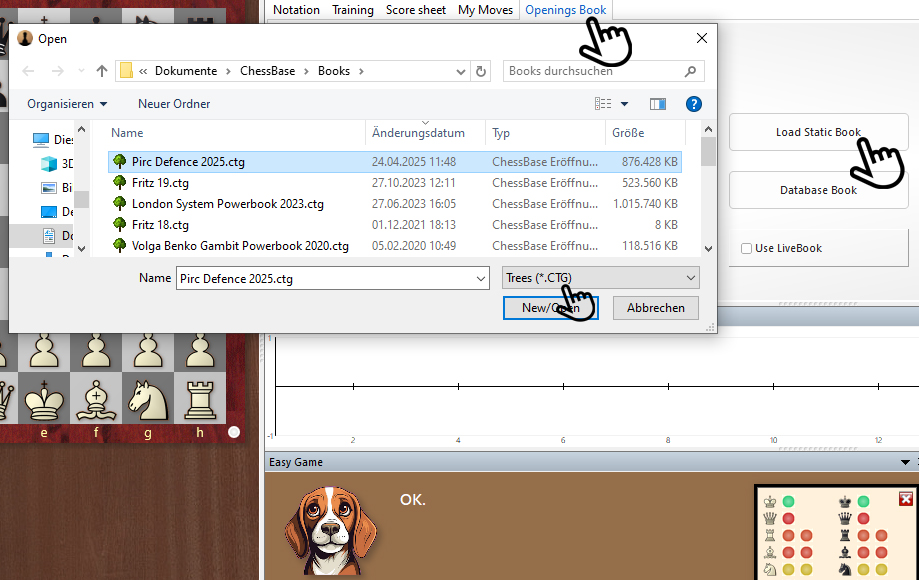
The index fingers (from top to bottom) indicate the clicks required to open a Powerbook: 1. Click on "Book" in the tabs of the notation window. 2. Click on "Open Book" in the Notation window. 3. Select the desired book in the window that opens; the selection is already preset to "Trees (*.CTG)".
The Pirc Defence Powerbook 2025 consists for a greater part of engine games (168 000), to which has been added high value material from Mega and the Correspondence Database (115 000).
For the launch of the Pirc Powerbook 2025 a minimum rating of rating 2200 was set for computer games, 2000 for human games. 115 000 games from Mega and correspondence chess crossed this threshold, to which were added roughly 168 000 from the engine room of playchess.com, making a total of 283 000 games. The Pirc Defence is considered risky from Black’s point of view, because the centre is conceded to White. On the other hand, that creates for Black a chance, because just like, e.g., in the Grünfeld Defence he can attack the white centre. Thus the Pirc Defence is well suited to playing for a win with the black pieces.
For this example, we have chosen the latest Powerbook on the Pirc Defence. After opening, the following picture appears:
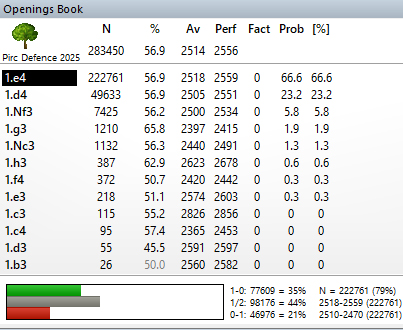
If we now click on the top move, which is the most frequently played move, we can see how the number of games (N) decreases. However, we can also see that after eight moves, there are still a large number of variations available:
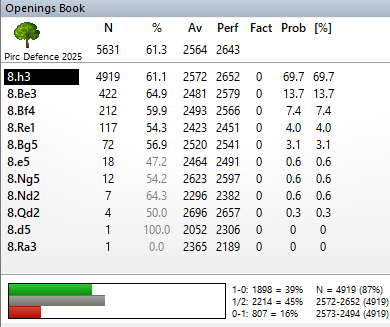
After five more moves, we have the following picture:
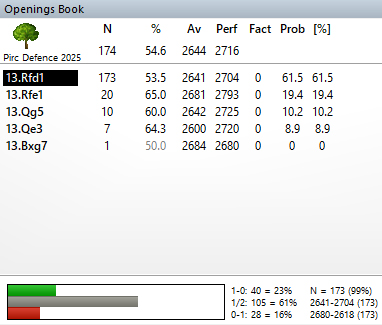
Here we see five remaining 13th moves by White. Both the number of games (N) and the Elo ratings (Av and Perf) indicate that 13.Rfd1 is a frequently played variation.
ChessBase or Fritz?
Here are two examples that show different ways of using Powerbooks in ChessBase and Fritz.
Example ChessBase:
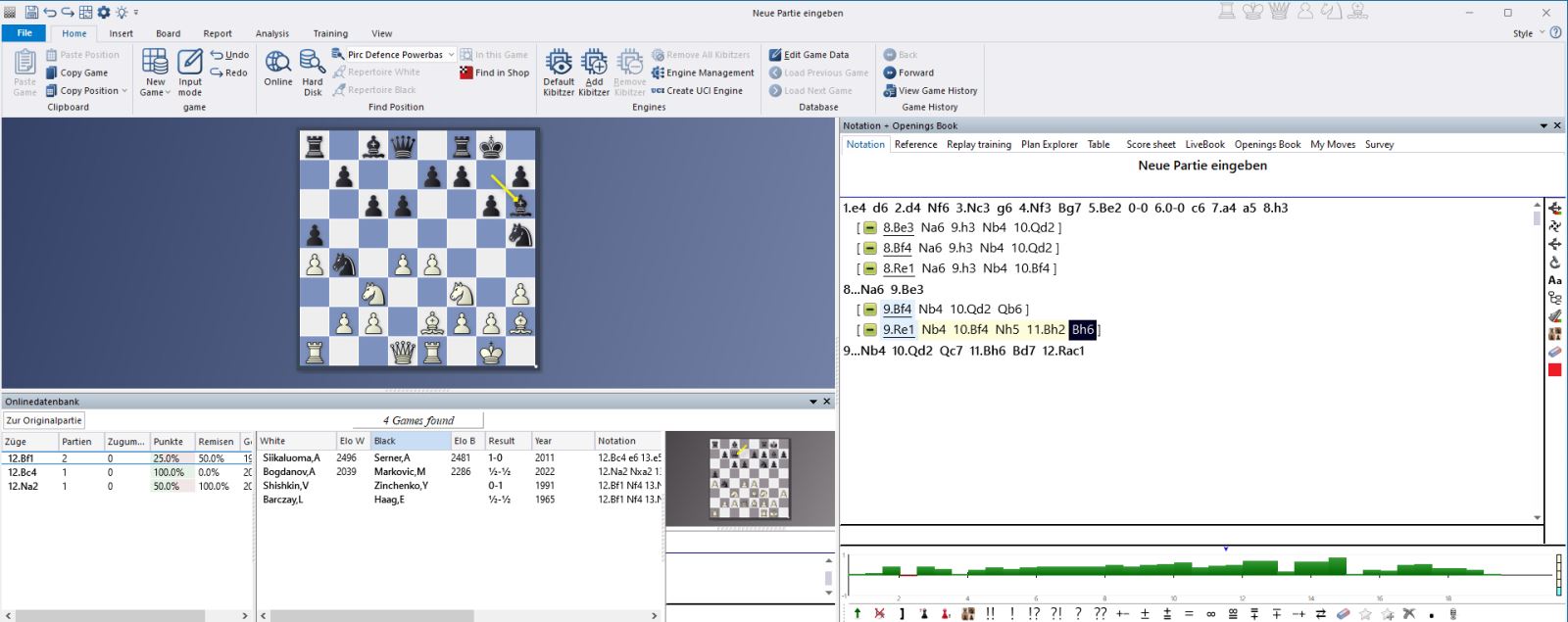
Lines have been added here by going back in the notation and selecting moves other than the most common ones. This allows you to build your own opening database. If you then add the Online or Megadatabase, as has been done here under the board, you will find suitable game material. This can of course also be inserted into the notation (right-click on the desired game and select "Copy to notation ..."):
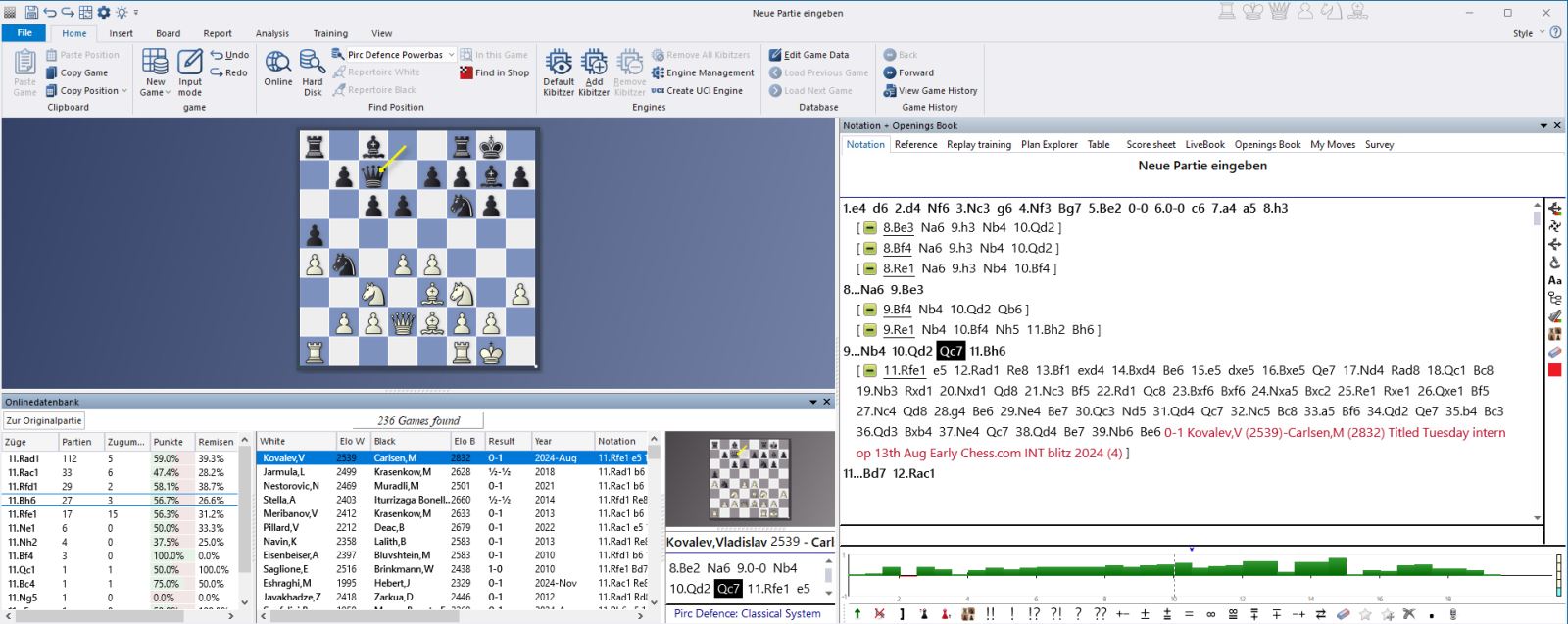
Example Fritz:
This (next screenshot) is an example showing the board, book and notation. Choose whether you want to start from the starting position or a specific position, and whether you want to play White or Black. You can prompt Fritz to move by clicking "Move Now!" (see finger).
You can also start a completely new game against Fritz and the opening book with "New Game White" or "New Game Black", or examine the desired positions with "Infinite Analysis".
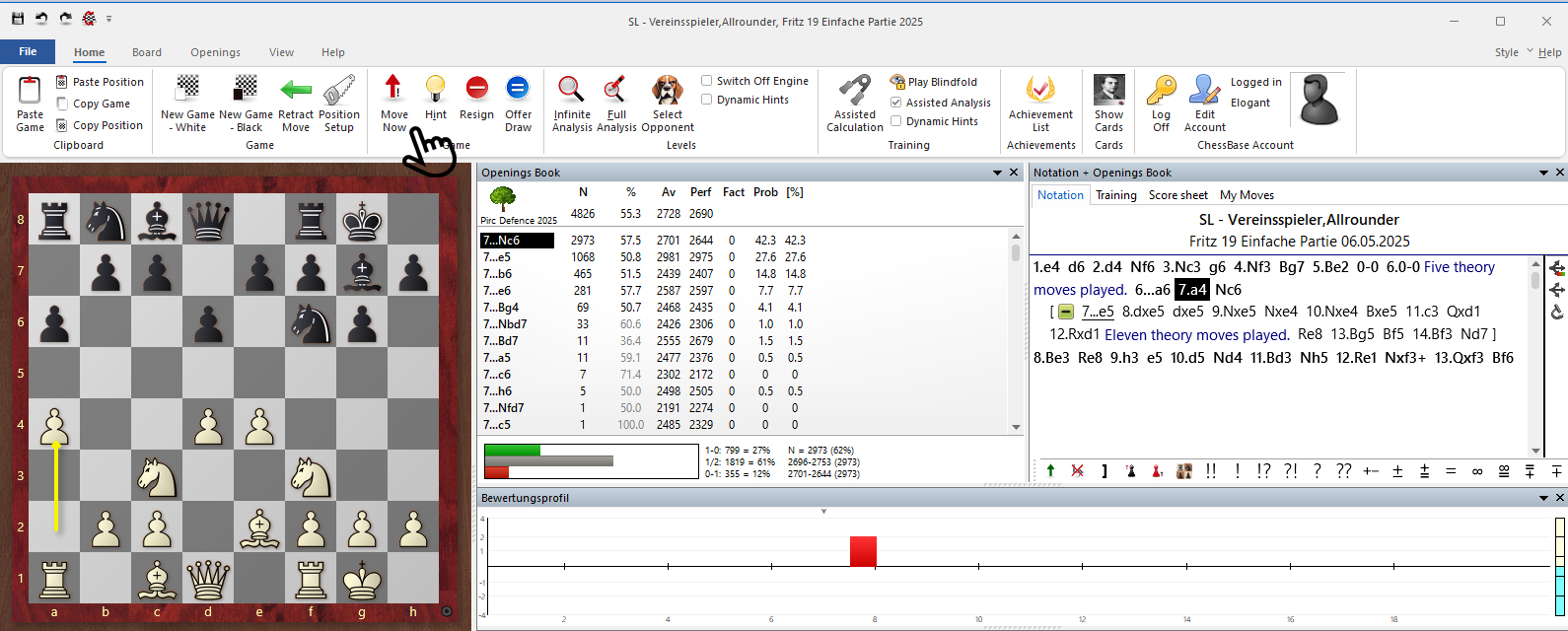
In all cases, Fritz will select variations from the tree, and you can decide how much you want to think for yourself or look at the moves in the tree. In any case, you will get a good overview of the variations.
Pirc Defence Powerbase 2025 is a database and contains a total of 10027 games from Mega 2025 or the Correspondence Database 2024; of these 874 are annotated.
The 874 selected annotated games offer outstanding material for study. Players such as Adhiban (2 annotated games), Kramnik (2), Gashimov (1), Karjakin (1) and Gelfand (4) have contributed analyses, but the lion’s share of the annotated games is down to Pirc experts Igor Stohl (145), Alexander Finkel (92) and Sergey Erenburg. There is a total of 10027 games in which the rating average is at least 2570.
You can open the Powerbase in the same way as the Powerbook. However, working with ChessBase is more useful here and corresponds to the databases we have already introduced in previous episodes.
The Reti Opening Powerbook 2025 has a tree structure based on a mixture of over 295,000 computer chess games, played in the engine room of playchess.com and the best games played by humans (137,000).
The Reti Opening Powerbook was based on an average of at least 2300 games. This means that 137,000 games from Mega and correspondence chess exceeded the Powerbook's entry threshold, plus 295,000 games from the playchess.com engine room. The original move order a la Richard Reti is 1.Nf3 d5 2.c4 followed by a fianchetto with g3 or b3 (or even the double fianchetto), but nowadays the term Reti opening is much broader and includes almost all possible variations after 1.Nf3 that do not go directly into well-known ‘grand’ openings. One plays 2.g3 (sometimes also 2.b3) more flexibly, usually followed by 3.Bg2 and 4.0-0. Depending on Black's set-up, one then decides how to proceed. The Reti-Powerbook includes as many game openings as possible after 1.Nf3, but no variations with early d2-d4, which would lead to the Catalan or King's Indian, for example. )
As always, we hope you enjoy trying out and discovering the many great features of ChessBase 18! With Powerbook and Powerbase, you have a huge knowledge advantage over players who do not use these resources. If you systematically exploit this advantage and continue to develop your working methods, you will quickly see the results...
Catalan Powerbook based on over 470,000 high-class games, most of them played by engines.
The games on which the Catalan Powerbook is based have an elo average of at least 2300. More than 415,000 engine games and 55,000 games from Mega 2025 + Correspondence Database 2024 exceed this elo threshold and form the basis for the Catalan Powerbook 2025. From White's point of view, the Catalan is an opening in which you can always rely on the enormous strength of the bishop on g2. For Black, Catalan is a rather unpleasant opening. You actually want to play the Nimzoindish or Queen's Gambit and now have to deal with the aggressive bishop on g2. However, Black can choose from a variety of systems (all of which White must know). In addition to the long main lines, where you either play 6...dxc4 or closed, early deviations - either 4...Bb4+ or 4...dxc4 with further options - have proven themselves in practice.
Catalan Powerbase 2025 is a database and contains 9158 high-class games from the Mega 2025 or the Correspondence Database 2024, 936 of which are annotated.
The 936 selected annotated games provide excellent study material. Top players such as Aronian (1), Eljanov (2), Esipenko (2), Gelfand (4), Giri (7), Karjakin (1), Kasimdzhanov (1), Kramnik (2), Le Quang Liem (1), Nakamura (1), Navara (3), Ponomariov (2), So (2), Vidit (4), Wang Hao (1), Wojtaszek (2) have analysed their games, plus commentaries by Catalan experts such as Ribli (265) and Marin (105) and other top-class authors. In total there are 9,158 games, with a rating average of at least 2570 (excluding games with commentaries and the Grünfeld experts Dubov, Andreikin and Gelfand).
------
ChessBase has evolved over decades to become what it is today with its 18th version. The programme has countless options, which we will introduce here in small chunks – so you can customise your interface for everyday use and continually discover and learn new options to get the most out of ChessBase 18 and save time.
You can find more tips and hints on our support pages and FAQ pages.
All parts of the series:
Beginner's Tips Part 12: Arrows and marks
Beginner's Tips Part 11: Multitasking with several windows
Beginner's Tips Part 10: "Standard Layout or Custom Layout"
Beginner's Tips Part 9: "Tactical Analysis"
Beginner's Tips Part 8: Putting Together What Belongs Together...!
Beginner's Tips Part 7: Organizing Your Database Correctly!
Beginner's Tips Part 6: Quick Command Bars and Variation Hierarchy
Beginner's Tips Part 5: Annotating
Beginner's Tips Part 4: Figurines and Colours
Beginner's Tips Part 3: Inserting Variations from References and the Engine
Beginner's Tips Part 2: Creating Variations and Activating the Engine
Beginner's Tips Part 1: Entering and Saving Your Own Games






























